Main objectives and conclusions of the study
Internal communications (IC) exists in every more or less large company. As soon as a company's headcount exceeds a certain magical number (usually, 150-200 employees), personnel services come to the owner with a proposal for an internal communications plan and budget. Such a process may be regarded as a sign of the company's "maturity", alongside a legal department or IT department.
The scope of operations by legal counsels or IT specialists is relatively clear. However, the role played by employees of the Internal Communications Department (including arrangements for the corporate New Year party), is an issue that requires explanation.
Moscow Consulting Group (MCG) conducted a survey among 20 heads of internal communication departments of large Russian and international companies. In the course of the survey, we attempted to clarify the following issues:
- What are the tasks and objectives of an internal communications department? Do they vary depending on the company's industry? Do they depend on the size of the company or on the social and demographic characteristics of their employees?
- What tools do internal communications departments have at their disposal? What is the difference between these tools in different companies? Which of these tools are the most popular and most effective? And how is the efficacy of their activities and initiatives measured?
- Which companies adhere to "the gold standard", which represents the best achievements in the field of internal communications, and why? And what are the advantages of using the best internal communications methods for the companies that practice them?
Evaluating the results of our study, we noticed that even the very concept of "internal communications" is perceived differently in different companies. Internal communications is understood as something like "soft-skills". There is no single accepted definition of this term – neither in Russian nor in foreign companies. For some it means activities related to retaining and motivating personnel, while for others it is a set of tools for conveying information to employees. The most advanced managers point out that the objective of internal communications is to craft a shared vision of the company, its objectives and values among staff members.
In our analysis, we did not evaluate the correlation between the level of development of internal communications and a company's area of activity, its size, form of ownership or other attributes. All companies use approximately the same set of tools, ranging from internal corporate portals up to a best employee contest. The difference apparently resides in how effectively such tools are applied. To what extent is the intranet convenient and useful for personnel? To what extent are corporate activities (managers' meetings and top management communication, contests and competitions) meaningful and attractive for the participants?
Our consultants are used to measuring any company initiative and assessing it from the viewpoint of economic efficiency and impact on the bottom line. Therefore, it is quite surprising that there are no definite KPIs directly related to strategic company objectives as well as almost a complete lack of understanding of the fact that such a link should be established and approved by the heads of internal communication departments.
Most internal communication experts highlighted the same issues – insufficient attention on the part of managers, the lack of knowledge and limited opportunities of learning from colleagues in other companies.
In our opinion, it will be possible to elevate the "status" of internal communication services if a way can be found to evaluate their economic efficiency.
This is by no means an easy process. However, in this case it would be reasonable to draw an analogy with the evolution of assessing customer service quality.
Most managers used to agree that customers must be served in a high-quality and polite manner, but what does "high quality and polite" service mean? How can we measure and assess the degree of "politeness" of an employee compared to others? And how does it affect the final result? What should an employee do if a customer requires more "attention and politeness" than provided for under the standards? Perhaps it would be better for an employee simply to focus on discharging his/her direct duties, and in this case, he/she would have time to serve more customers, and consequently, bring more money to the company.
This was the prevailing mentality until about 10 years ago. Today, however, the ability to assess the "quality and politeness of service" has become virtually standard operating procedure. Training sessions are held for employees, while funds are spent on continuously collecting and processing feedback from customers.
Without a doubt, generally accepted KPIs and motivation tools do exist and can be used to assess and reward the quality of the employees' work.
So what did happen?
First abroad, then later, in Russia, companies learned to correlate service quality with the overall performance of a company. Studies were performed proving that each "unsatisfied" customer will, with N% probability, tell X number of other existing and potential customers that he/she will refuse the service of this company with Y% probability. By knowing the average bill of a customer, it is possible to mathematically calculate the amount of lost profit and the direct impact on financial performance. Such a calculation can be made more complex and adjusted to determine the parameters depending on the socio-demographic segment of customers, the geographical location of the object, the company's product and other factors.
The main tasks of the internal communications department are to interpret the common values and strategic objectives of the company, to keep personnel up-to-date about the company's activities, while raising motivation and the team spirit of staff.
We are confident that within 5-10 years internal communication departments will also begin to apply a generally accepted and motivated methodology representing the relation between the quality of work and the company's overall performance. First, advanced companies (i.e. those where the managers are interested in the maximum effectiveness of their personnel), through trial and error, will attempt to find the relation between the shared system of values of employees and the company's financial performance. Later, their experience will gradually spill over to other companies. It is obvious that being Number One is difficult, and, in most cases, costly. For this reason, below we shall propose several trends and ideas that pioneer managers can try to use even today.
- Employees communicate the company's strategic objectives to the outside world, i.e. to available and potential customers and employees in a unified and exact manner. In this way, they attract and retain people with certain values that are consistent with the company's mission;
- In their activities, employees may independently set priorities based on a clear understanding of the company's strategy. For instance, in case of a non-standard situation an employee has a certain reference point (the company's values) and can make a corresponding decision;
- The employees whose personal values coincide with the strategic tasks of the company will remain employed for a longer period and will move up the company's career ladder more quickly;
- Employees are notified on a timely basis about company events, and the company, in turn, promptly obtains feedback. Therefore, the manager can better understand if the personnel supports the strategy and tactics of the company;
- The employees know their managers, believe in their abilities and support their initiatives. This, in turn, enhances loyalty to the company and creates additional incentives for personnel.
Detailed description of study results
Our study of internal communication (IC) practices and tools was conducted from December 2016 through March 2017. The participants were representatives of 20 companies: 11 Russian companies and nine representatives of international companies in Russia in such areas as retail, finance, health care, consulting, etc.
While interviewing the heads of internal communication departments we found out that the budgets of these units are rather small and account for less than a third of the budget of the company's external communications (PR), excluding the costs of the corporate New Year parties. The typical headcount in internal communications is also rather small – on average, one specialist per 3,000 company employees
An example of participating companies as well as the description of the company's size and industry are shown in Figure 1.
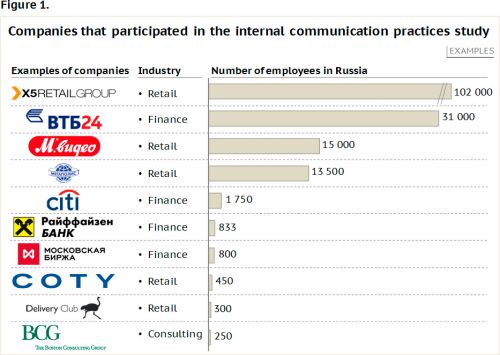
In the course of the survey, most experts listed the entire basic set of internal communication tools (newsletters, intranet, and meetings of managers with personnel).
However, only less than half of the surveyed companies use more complex digital tools, thus revealing the current preferences of modern urban inhabitants for content consumption (corporate messengers, mobile applications and videos), or such original approaches to implementation of corporate culture as "value ambassadors". Value ambassadors are employees who voluntarily help their colleagues learn using the company's values in their everyday work environment. In this respect, our respondents consider messengers and value ambassadors, alongside manager meetings with personnel, to be the most efficient tools.
The frequency of internal communication tools usage as well as the opinion of our respondents concerning the effectiveness of such tools are shown in Figure 2.
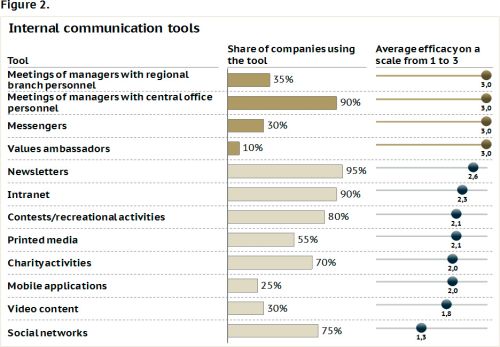
Despite the fact that the set of tools used is generally quite similar, the level of internal communications development varies quite significantly among the companies. In the course of our study, we identified three stages in the evolution of internal communication functions. Such a division is no doubt rather conventional, and the quality of various internal communication aspects may vary within a single company. Nonetheless, the internal communication processes in the companies that were rated within the same group display more similarities than differences.
The first group includes companies that have a basic set of internal communication processes (1). This refers mainly to such functions popular in the business as organization of activity and notifying personnel about key events. Here the minimum set of communication tools is used (intranet, corporate magazine, newsletters) and, as a rule, there is neither an elaborate strategy nor an objective efficiency evaluation. This group includes mainly small companies that have only recently started to adopt internal communication tools, or the branches of large international companies without extensive business localization (for instance, small branches of international banks with a limited range of products offered in the Russian market).
The predominant number of respondent companies in terms of internal communications development have been classified in the group we refer to as a key service (2). It implies a wider set of internal communication tools and a higher level of application thereof. In such companies, internal communication specialists initiate activities aimed at improving personnel involvement, while actively developing the existing channels and launching new channels. In this case, the internal communication strategy may be part of the company's overall communication strategy, and the approaches to the tools used for effectiveness evaluation may include both the personnel satisfaction survey and the main users' statistics on the attendance of activities and visiting information pages for digital communication channels. At such companies, managers understand that there is a certain overlap between the company's success and the personnel motivation level, although no attempts to determine the correlation between the financial result and the internal communication tools efficacy have been made.
At 2-3 of the companies we selected, internal communications play a significant and sometimes even decisive role in the task of increasing personnel involvement, so we refer to them as a core function (3). These companies carry out systemic work with the employer's brand, and the internal communications department may initiate common strategic projects with the business. In this case, the internal communications strategy is cascaded from the company's strategy, and effectiveness is evaluated using a wide set of methods, starting from focus groups up to a detailed assessment of the user statistics by each digital channel on the level of a popular web portal.
In Figures 3 – 5 we indicated each of the above-described groups as

The difference in the level of development of internal communications at companies is displayed in the specific features of tool application. Thus, Group 3 companies not only use the newest digital technologies, but also find a way to enhance the effectiveness of traditional tools using non-standard approaches (for instance, such as political strategists when preparing CEO speeches in regional representative offices).
Figure 3 shows the specific features regarding application of internal communication tools at the companies that participated in the study.
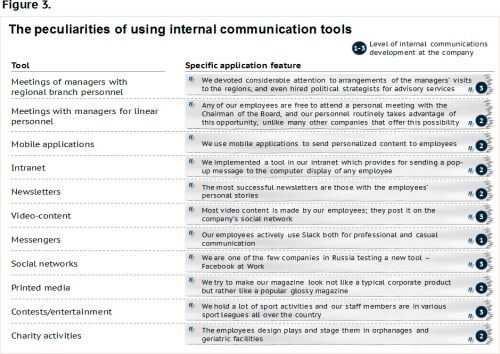
Figure 4 illustrates the differences in approaches to effectiveness evaluation used by the companies classified in various groups.
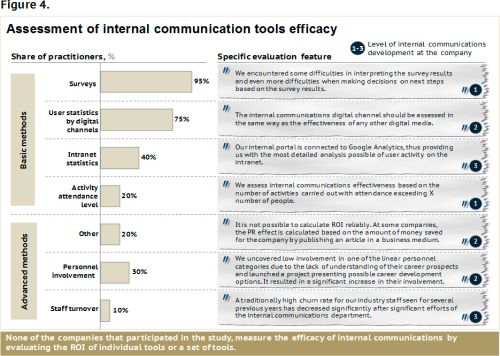
Unfortunately, there is not a single company in our selection that measures the relations between internal communications and business results. Meanwhile, this is an issue that causes considerable difficulties for internal communication departments in their work.
In Figure 5, we highlight the main obstacles limiting the capacities of internal communication services as mentioned by our respondents.
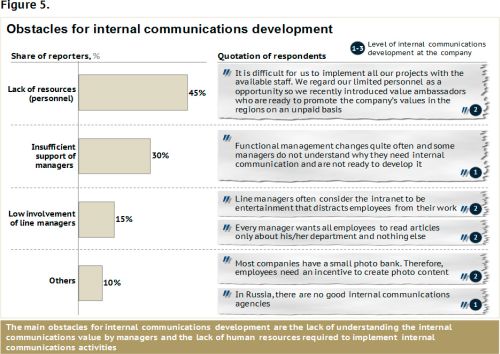
The content of this article is intended to provide a general guide to the subject matter. Specialist advice should be sought about your specific circumstances.


